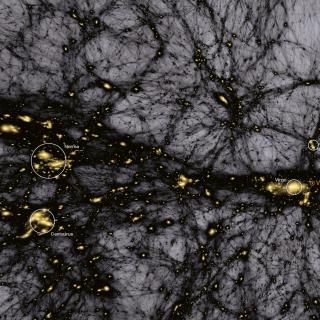Bibcode
García-Farieta, Jorge Enrique; Balaguera-Antolínez, Andrés; Kitaura, Francisco-Shu
Bibliographical reference
Astronomy and Astrophysics
Advertised on:
10
2024
Journal
Citations
7
Refereed citations
5
Description
Context. We assess the effectiveness of a non-parametric bias model in generating mock halo catalogues for modified gravity (MG) cosmologies, relying on the distribution of dark matter from either MG or Λ cold dark matter (ΛCDM) simulations. Aims. We aim to generate halo catalogues that effectively capture the distinct impact of MG, ensuring high accuracy in both two- and three-point statistics for a comprehensive analysis of large-scale structures. We investigated the inclusion of MG in non-local bias to directly map the tracers onto ΛCDM fields, which would significantly reduce computational costs. Methods. We employed the bias assignment method (BAM) to model halo distribution statistics by leveraging seven high-resolution COLA simulations of MG cosmologies. Taking cosmic-web dependences into account when learning the bias relations, we designed two experiments to map the MG effects: one utilising the consistent MG density fields and the other employing the benchmark ΛCDM density field. Results. BAM generates MG halo catalogues from both calibration experiments with excellent summary statistics, achieving a ~1% accuracy in the power spectrum across a wide range of k modes, with minimal differences well below 10% for modes subject to cosmic variance, particularly below k < 0.07 h Mpc‑1. The reduced bispectrum remains consistent with the reference catalogues within 10% for the studied configuration. Our results demonstrate that a non-linear and non-local bias description can model the effects of MG starting from a ΛCDM field.
Related projects

Cosmology with Large Scale Structure Probes
The Cosmic Microwave Background (CMB) contains the statistical information about the early seeds of the structure formation in our Universe. Its natural counterpart in the local universe is the distribution of galaxies that arises as a result of gravitational growth of those primordial and small density fluctuations. The characterization of the
FRANCISCO SHU
KITAURA JOYANES